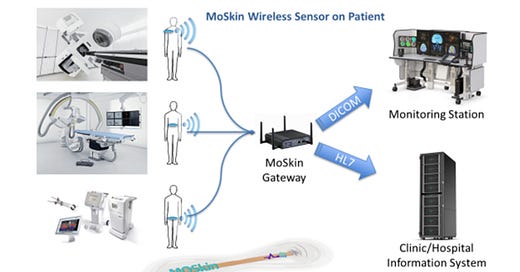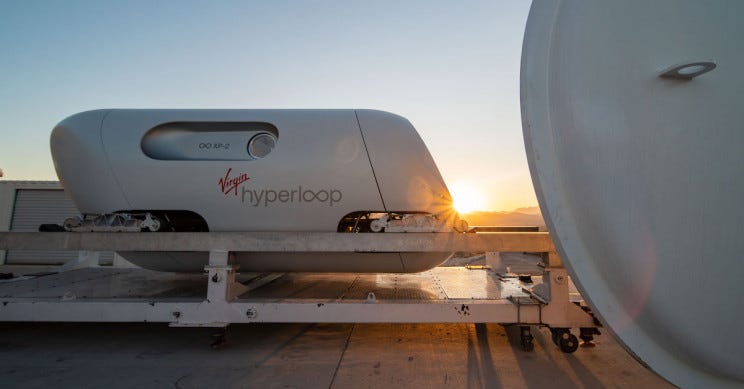Radiotherapy accuracy, Brain-Computer interfaces and AI solving Partial Differential Equations
November 12
This week we will look at a new device that improves the outcomes for patients undergoing radiotherapy. We also look at a breakthrough brain-computer interface that allows people with upper body paralyzes to interface with a computer and we discover an AI that solves Partial Differential Equations (and we discover why this is important). Finally we will look at progress on the Virgin Hyperloop.
MOSkin Sensors
Developed by Australian startup Electrogenics Labs, MOSkin sensors are a wireless radiation sensor technology that is able to precisely measure the depth and intensity of radiation in real-time during cancer and other radiotherapy treatments.
Various Radiotherapy treatments use high levels of ionizing radiation to target specific areas in the body as part of treatments. Unfortunately that radiation is also absorbed by subcutaneous tissues and can induce long term detrimental side effects, including secondary cancers. The difficulty clinicians face is they have no real-time measurement of radiation doses that are being delivered.
The system can measure at a skin depth of 0.07mm and does not disrupt any radiation beams. It is also invisible to x-rays and is radio-transparent. The system is easily retrofitted to current equipment and can be single use or multi use.
MOSkin won the “Overall” and “MedTech and Pharma” prizes at the 2020 Australian Technologies Competition. The team is currently working on commercializing the product and is looking for partners. Get in touch with them here or drop me a note and I will put you in touch.
AI has cracked Partial Differential Equations
Some math is hard but Partial Differential Equations are another level of difficulty altogether. Most of us have never come across them and probably never will however they are very useful for describing the physical phenomena in the universe. They can be used to describe planetary orbits, air turbulence from aircraft engines, the motion of fluids and the earth’s plate tectonics.
If you were developing a new aircraft engine and wanted to simulate the air turbulence that would be created by the new design you would use a Partial Differential Equation (PDE) called Navier-Stokes. This allows you to model how the air was moving and how it would move at any point in time during the operation of the engine. The problem is that these equations are extremely complex so require Supercomputers to do the math.
Researchers at Caltech have introduced a new deep learning technique for solving PDE’s that is dramatically more accurate than previously used methods. The AI is able to solve the entire families of PDE’s (e.g. Navier-Stokes for any type of fluid) without retraining. The AI is 1,000 times faster than traditional methods. This reduces reliance on computing power and opens up the potential for solving bigger problems more accurately.
The gif below shows how the system predicts a fluids’ motion from an initial condition and compares it to the actual movement.
The AI will not only be useful for developing new aircraft (or any vehicle), it will also be useful in developing fine grained weather predictions, seismology and materials science. Solutions such as this are invisible to most of us however they will have a significant impact on the speed and quality of innovation.
Virgin Hyperloop
The Hyperloop is a proposed form of passenger and freight transportation where people or goods travel in a pod through an airless tube at up to 1,500 kilometers per hour. The idea was first floated by Elon Musk in 2012. His companies have run multiple competitions for various parts of the system. An Australian startup, VicHyper, from Royal Melbourne Institute of Technology won the prize for best braking system in a 2016 competition.
There are many initiatives underway around the world, one of which is being developed by Richard Branson’s Virgin Corporation. This week in the Nevada Dessert they ran a pod with two passengers (the Company’s CEO and the Head of Customer Experience) reaching 172 kph on a track 500 meters long. This was the first customer transport and initial proof of concept.
The goal is to connect the center of major cities with a simple turn up and go transport system that will match the speed of air transport. Hyperloops will most likely run in tunnels or above ground tubes and be able to transport passengers from CBD to CBD quickly and efficiently. Pods carrying up to 28 people are planned by Virgin. The current systems use electromagnetic propulsion systems and are being planned for cities in the Middle East and the US.
Imagine being able to travel from Sydney to Melbourne in 30 to 40 minutes for a couple of morning meetings and being back in Sydney in time for lunch.
Brain-Computer Interface
Researchers at the University of Melbourne have developed a brain-computer interface the size of a paper clip. It allows people with upper limb paralysis to text, email and search the internet.
The device, a Stentrode, has been successfully implanted into two patients suffering from Motor Neuron Disease (MND). The two patients were able to carry out daily tasks such as online shopping, texting and banking.
The devices were implanted into the patients through their blood vessels, next to the brain’s motor cortex via a small keyhole incision in the neck. The participants used thought to power the device and a machine learning algorithm helped to adapt the device to their movements. Synchron is the commercial partner.
Paying it Forward
If you have a start-up or know of a start-up that has a product ready for market please let me know. I would be happy to have a look and feature the startup in this newsletter. Also if any startups need introductions please get in touch and I will help where I can.
If you have any questions or comments please email me via my website craigcarlyon.com or comment below.
I would also appreciate it if you could forward this newsletter to anyone that you think might be interested.
Till next week.
PS Happy Birthday to my sister, I am curious to see if she reads this far into the newsletter








Hyperloop Marketing problem is no-one will travel for face to face meetings any more..Fun though.
.